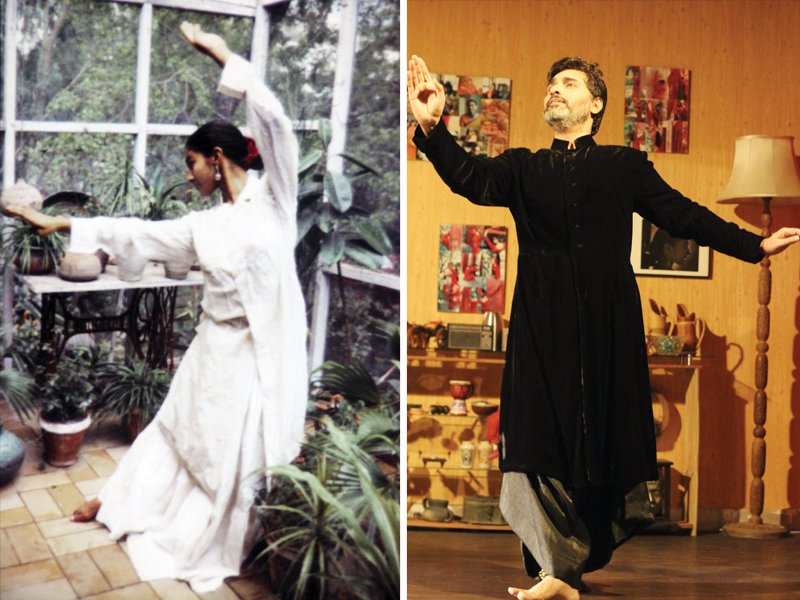
The small room bathed in soft yellow lamp light was decorated with pictures of some of her best performances and her college days. Olomopolo Media organised the event Remembering Jahan Ara on Sunday to mark her 16th death anniversary. Her father Zahoorul Akhlaq, famed painter, sculptor and architect, had been home when a man walked in and shot him and his elder daughter dead. Her mother, Sheherezade Alam, is a ceramist and founder of Jahan- i-Jahanara, a centre for traditional arts for children aged between 8 and 12 years.
The room was abuzz with whispers of Jahan Ara and her teacher Maharaj Kathak. “How many of you had met her?” asked actress Sania Saeed. No one replied.
Saeed read out a letter Jahan Ara had written to famed dancer and choreographer Guru Chandralekha on October 11, 1998. She had received a scholarship to learn dance at the Chandralekha Dance Company in Chennai (then Madras) but left the academy after only three months. Jahan Ara said that she had not enjoyed working with the company. “I don’t know what I want but I do know what I do not want. I do not want to be unhappy. I cannot work in a negative space.”
Zoya Sajid, one of Sheherezade Alam’s close friends, recalled her meetings with Jahan Ara. “When Jahan Ara gave up her scholarship I asked why she had forgone such an amazing opportunity. She told me that she could not love her guru enough to learn from her.” Jahan Ara said that she used to get stared down for tying her hair in a bun that would come loose during her performances.
“I remember Jahan Ara performing to Baba Farid’s poetry,” she said. “This was Jahan Ara – bearer of the red flames.”
Artist Mira Hashmi, one of Jahan Ara’s childhood friends, said that she had a set of drawers stuffed with childhood memorabilia. In those drawers, she had kept letters that Jahan Ara had written to her from the US. “Pakistan is where you can truly live life,” Hashmi read out. “People here [in America] don’t even know how to tell jokes.”
Hashmi recalled their sleepovers where sleep never featured. “We would always end up on the rooftop singing classics till dawn.”
This one time, a wonderful performance by Naheed Siddiqui at Ali Auditorium had left Jahan Ara in raptures, Hashmi recalled. “She ran backstage to see Siddiqui but fell into a 10-foot deep pit and had to get stitches. My grandmother used to comment on how strange she looked wearing her peshwas with a cap to hide the stitches.”
At an event held in the memory of Faiz Ahmed Faiz, Jahan Ara performed on a few verses of the poet. “Her hands in cuffs, Jahan Ara prostrated herself during the performance and the audience burst into applause. It was a dramatic moment,” Hashmi said. Jahan Ara flashed a smile to the audience, her teeth gleaming in the light. “I still have that flashback.”
Hashmi’s talk ended with the screening of one of Jahan Ara’s performances.
Faryal Gohar remembered one of Jahan Ara’s performances at the Goethe Institut. “She danced under a banyan tree in front of the institute. It was so intense that I was afraid for her and was moved to tears.” What Jahan Ara did there was not humanly possible, Gohar said. She compared her to Farida Kahlo. “The world just did not deserve Jahan Ara.”
Gohar said she had approached Jahan Ara to perform in a documentary that she was planning at that time. She said she had told her that the character she wanted Jahan Ara to play was deaf. “Jahan Ara replied you don’t have to listen to music to dance...music is within you.”
Pointing to one of her pictures, Sania Saeed said that when actor Sarmad Khoosat saw this picture he had exclaimed, “Look at this face, it isn’t real!” Saeed said, “Yes it’s not real. This face wears brains.”
Adnan Jahangir paid a tribute to Jahan Ara through a dance performance. He said she had inspired him to take up dancing as a career. Jahangir’s performance transported the audience to a world of music and grace.
“My daughter was a very hardworking girl...this is why she picked up things fast,” said Sheherezade Alam. She spoke of her daughter’s regard and love for her guru Maharaj Kathak. “My father went to visit Kathak when Jahan Ara was born...later she chose to learn the beautiful art from him.”
Published in The Express Tribune, January 20th, 2015.










































COMMENTS
Comments are moderated and generally will be posted if they are on-topic and not abusive.
For more information, please see our Comments FAQ